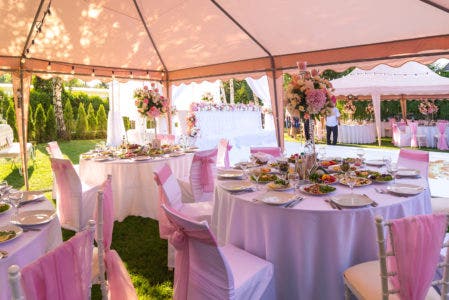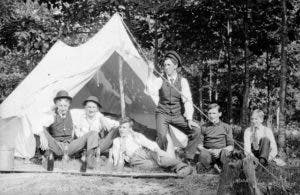Staking Down the History of Party Tents
Do you think Neanderthals spent any time partying inside their ancient hide covered tents 40,000 years ago? If so, they would’ve invented the concept of the “party tent,” kicking off the history of party tents “caveman style”. And what a party that would’ve been, eh? Eating a mammoth, clubbing each other, buying car insurance … they really knew how to have fun.
Of course, we really don’t know if Neanderthals were having wild parties back then or not. What happened in the Ice Age stayed in the Ice Age. So as far as we can tell, party tents are actually a lot younger than most of us probably think they are. As we know them today, anyway.
Party tents have become so synonymous with backyard parties, weddings, graduations, festivals, and other outdoor events, it’s hard to fathom they didn’t even exist one hundred years ago, not in their modern fashion anyway. What we know today as party tents only really date back to the middle of the 20th century.
Tents have been used for various types of gatherings and events for millennia, but commercial party tents wouldn’t exist as a concept until the 1920’s and 1930’s. The lightweight, heavy duty commercial tents used by your rental business today have a fascinating history dating all the way back to antiquity. So let’s take a few minutes to explore the surprisingly interesting history of party tents, shall we?
Ancient Party Tents
We aren’t going to discuss the broader history of tents, but we will state that tents have been used for all sorts of social, cultural, religious, and casual events for thousands of years.
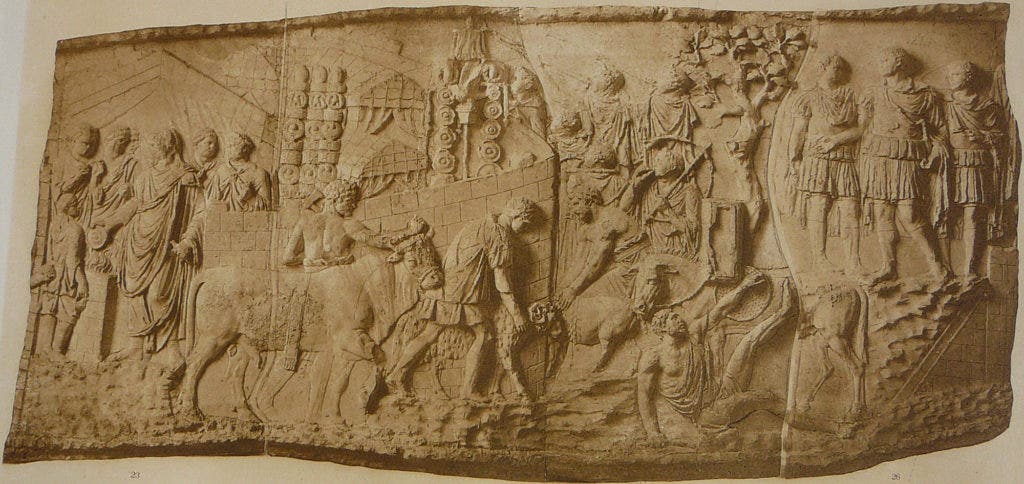 Ancient Roman legions were split into small contubernium, infantry units of eight men each, who would share a tent while traveling. Soldiers would gather in these tents for evenings of drinking while off to war in military campaigns. Of course, the contubernium tents weren’t really “party tents” as we know them today, but they were prolific throughout the ancient Roman Empire and may have been the first heavily produced and widely distributed tents used by large swaths of people.
Ancient Roman legions were split into small contubernium, infantry units of eight men each, who would share a tent while traveling. Soldiers would gather in these tents for evenings of drinking while off to war in military campaigns. Of course, the contubernium tents weren’t really “party tents” as we know them today, but they were prolific throughout the ancient Roman Empire and may have been the first heavily produced and widely distributed tents used by large swaths of people.
The chuppah are the earliest known wedding tents. These simple but attractive canopy tents have been used for as long as Judaism has existed. A chuppah is erected with open sky above it, and is meant to symbolize the home the newlyweds will build together. And as we’ll discuss later, the chuppah likely played a significant role in popularizing contemporary outdoor weddings, too.
Outside of Jewish weddings, the idea of holding outdoor parties was lost on most of the ancient world. Tents were used as homes, for hunting, or for military excursions. There was no such thing as “camping” for fun. And it would remain that way for a pretty long time, too, until the idea of recreational camping began to spread in the wake of the American Civil War.
Camping for Leisure Goes Mainstream
Recreational camping as we know it today owes itself to transcendentalist writers like Henry David Thoreau and Walt Whitman, as well as artists like Asher Durand and Thomas Cole. These famous figures romanticized the American wilderness and helped inspire the core concepts that would come to fuel the American conservation movement.
As American pioneers traveled west to fulfill their visions of Manifest Destiny, camping was an essential element of their survival. And that helped romanticize the idea of camping among those who remained behind on the East Coast, to whom the great westward expansion seemed like an incredible adventure.
All of this would come together in 1869, when a minister named William Henry Harrison Murray published his book Camp-Life in the Adirondacks. Murray’s book inspired thousands of tourists to visit Lake Saranac in New York’s Adirondacks, unknowingly becoming the earliest pioneers of what would come to be a great American pastime. And later, the creation of State and national parks would provide more areas for campers to explore.
Of course, you can’t really talk about camping without mentioning the Boy Scouts. Robert Baden-Powell, an experienced British military scout who had worked in British India in the 1880’s and Africa in the 1890’s, authored the book Scouting for Boys in 1908 and developed what would later come to be known as scoutcraft. The first scout rally was held at Crystal Palace in London, England shortly thereafter.
The Boy Scouts and Girl Scouts played significant roles worldwide in spreading knowledge regarding the use of tents all throughout the 20th century, and continue to do so today. Recreational camping in its present form simply would not exist without these groups. And as we’ll explain soon, neither would the party tent.
Some Very Jazzy Wedding Tents
The jazz age saw the birth of the contemporary wedding tent, transforming the concept of wedding tents from a spiritual necessity into mainstream consumerism.
The economic boom of the 1920’s brought about a number of niche markets, and the bridal industry was definitely a big one. Wedding supply vendors began heavily marketing their products and services specifically to brides and their families, encouraging everyday people to experience the sorts of lavish, extraordinary weddings previously only enjoyed by royalty and the extremely wealthy.
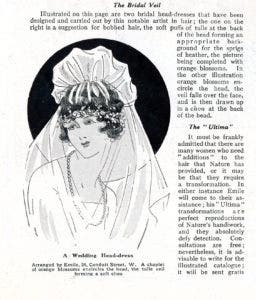 Capitalizing on this newfound concept of weddings being special events that could fulfill every woman’s dreams, Marshall Fields invented the wedding registry in 1924, which quickly rippled through the retail world and was adopted by practically every store under the sun. This helped lead to more impressive and unique weddings, which in turn inspired many couples to hold outdoor weddings. And thanks to the popularity of camping, more Americans knew how to raise tents and appreciated their broader value than ever before.
Capitalizing on this newfound concept of weddings being special events that could fulfill every woman’s dreams, Marshall Fields invented the wedding registry in 1924, which quickly rippled through the retail world and was adopted by practically every store under the sun. This helped lead to more impressive and unique weddings, which in turn inspired many couples to hold outdoor weddings. And thanks to the popularity of camping, more Americans knew how to raise tents and appreciated their broader value than ever before.
By the later half of the 1920’s, outdoor weddings had become popular enough that rental companies were starting to spring up in urban areas. A number of companies were now buying or crafting high quality pole tents, and then renting them out to wedding organizers and party planners.
The popularity of wedding tents expanded further thanks to growing numbers of Jewish immigrants holding outdoor weddings in the United States with their chuppahs. If not for these Jewish immigrants, our modern day party rental industry would look very different … or perhaps not even exist at all.
The Roaring Twenties ushered in the advent of the wedding tent, and played a key role in the overall history of party tents. The Great Depression threatened the fledgling party rental industry’s progress—many brides planned more frugal weddings than they would have in the 1920’s, surely—but wedding tents had already made their mark on the bridal industry.
From Party Tents Back to War Tents
World War II was a very different type of war from those fought prior. Soldiers were no longer fighting in trenches as they had in the first World War, nor were they lining up and engaging in huge open field battles like they had before that. WWII fighting was more tactical than strategic. Soldiers fought in bursts while roaming, requiring rapid mobility and the ability to make and break camp quickly.
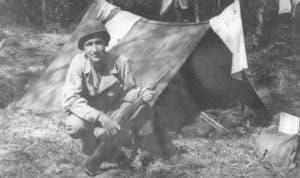 WWII required tentmakers and canvas workers to reexamine the core concepts of designing and manufacturing tents. They needed to be lightweight, simple to deploy and strike down, and crafted on a budget, all with replaceable, modular parts. The tent poles from one unit needed to be usable on the next unit over. And tent fabric needed to be easily and effectively patched on the fly.
WWII required tentmakers and canvas workers to reexamine the core concepts of designing and manufacturing tents. They needed to be lightweight, simple to deploy and strike down, and crafted on a budget, all with replaceable, modular parts. The tent poles from one unit needed to be usable on the next unit over. And tent fabric needed to be easily and effectively patched on the fly.
These requirements brought about massive changes to the tent industry, not only in how tents were produced, but in the materials used and in the quality of their components. It also helped transition tent-making from niche handcrafting to the factory floor, which would prove vital to the growth of commercial tents after the war.
The Baby Party Tent Boom
The post war era was perhaps the most pivotal period in the history of party tents, as several major factors would all culminate to give birth to the modern party rental industry.
Veterans returning home from the war were perfectly positioned to create exciting new lives for themselves. The post war economy was booming. Jobs were plentiful. It was easier than ever to buy a home and a car. These vets could marry that high school sweetheart they’d exchanged letters with during the war and raise a family in this newfound “middle class” that had never existed prior.
Returning veterans had grown all too familiar with the small wall tents, pyramidal tents, and pup tents they had used overseas. That, coupled with the booming post war economy, saw recreational camping enter the mainstream again. And this was driven even further (pun slightly intended) by the birth of the American Interstate highway system, allowing regular people to go on vacations and travel greater distances recreationally than ever before.
Companies like Eureka! of Binghamton, New York and Coleman of Kingfisher, Oklahoma played pivotal roles in shaping camping tents in the post-war retail sector. Eureka! led this charge with their self-standing tents of the 1950’s and 1960’s, which became so popular that Sir Edmund Hillary used them on his expedition to the peak of Mount Everest in 1963. Those camping tent improvements helped revolutionize party tents, too, and the processes by which tents were (and still are) produced.
The History of Party Tents is Still Being Written
These industrial and commercial advancements in camping tents helped bring about the full potential of party tents, proving they weren’t just used for outdoor weddings anymore. They became lighter and easier to erect. Consumers were setting them up for backyard parties. Companies were using them for corporate events and trade shows. By the 1950’s, party tents and event tents had become mainstream.
The heyday of wedding tents was only just beginning. Celebrity weddings in Hollywood were starting to dominate the headlines, and high-profile weddings were becoming the norm. The 1953 wedding of John F. Kennedy and Jackie Bouvier featured images showcasing wedding tents used in their Rhode Island reception, which helped popularize outdoor weddings even further.
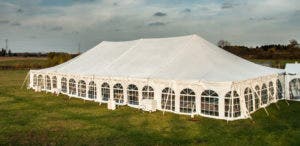
The coming decades would see tent designs expand, thanks to the advent of frame tents, pop up tents, and high peak frame tents. Tents were now being specialized to cater to the structural, spatial, and aesthetic needs of varying types of events. Meanwhile, standardizations in tent sizes, brought about in part by their mass production, allowed party and event planners to maximize their planning efforts and shrink their design and layout times.
Modern party tents are built using advanced materials, like the heavy duty commercial grade vinyl and anodized aluminum we use here at Tent and Table. They’re built to higher standards than their ancestors, ensuring their durability and longevity. They’ll undoubtedly continue to be improved on over time, too.
We don’t know what the future might hold for party tents, but we do know said future will be exciting. If the history of party tents has taught us anything, it’s that innovations in our industry ebb and flow with the social and economic fortitude of the nation. And that’s surely something interesting to think about at future backyard parties and outdoor weddings.
[product ids="3709,4191,4119,4577"]


